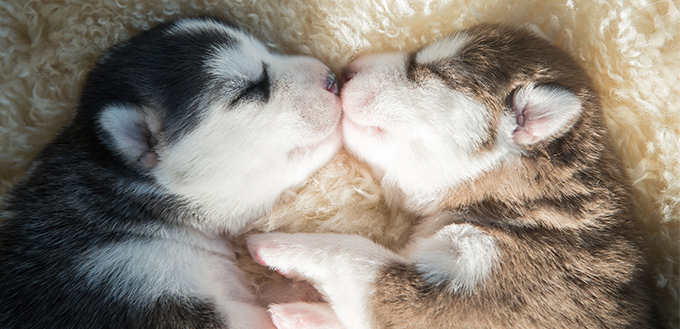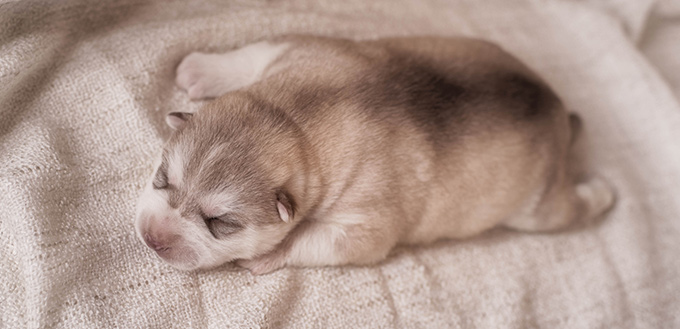Puppies are born with both their eyes and ears closed. In most breeds, the eyes begin to open around two weeks after birth, before this time the puppies are completely reliant on mum and their owner for their health, welfare, and safety. Even after they open their eyes puppies require a great deal of care as their eyes and ears are far from fully functional at this stage. Why are puppies born so helpless and what do you as the breeder need to do to support their growth and development?
Why Puppies are Born So Helpless
Newborn puppies appear to be incomplete and helpless. They are born functionally blind and deaf, with their eyes and ear canals closed. While most puppies are now born in comfortable homes, with both mum and a caring owner to care for them and keep them safe, it is difficult to see how the puppies of their wild ancestors survived in this state. At first glance, it seems as if evolution has slipped up. After all, in the wild the puppies would be helpless, being born in a state were two of their major senses do not function. And even once they begin to function they provide little useful information for survival for at least a couple of weeks.
What at first glance looks like an evolutionary mistake is however part of the key to why dogs have been such a survival success. To understand this, you need to delve a little deeper into the evolutional extremes of mammals.

Evolution and Mammals
It is widely accepted that over time mammals have changed and adapted to better cope with their surroundings and give their species the best possible chance of survival. These changes affect reproduction and development just as much as they affect body shape, size, and hunting techniques. This means that each species had to make a choice – evolutionary speaking – has to which strategy would give them the best chance of survival. The choice was between a longer pregnancy that results in a more fully formed and functional offspring, or a shorter pregnancy and more helpless offspring that require much more care, time, and attention. On the surface the choice seems obvious – however, it is far from it.
The evolutionary choice needed to fit with the animals surrounds and the behavior patterns that they engaged in to support their continued survival. At one end of the evolutionary extreme are mammals that biologists refer to as “precocious”. These are mammals whose offspring display characteristics of exceptionally early maturity or development. This would include animals such as cattle and deer. Pregnancy in a cow lasts for nine months and the newborn calf is born with a fully formed brain and is able to use its senses efficiently. More importantly in a very short space of time it has effective control of its limbs as well. This means that it is able to move and keep up with the herd. Such early maturity is ideal in these species as it allows them to run away from predators and the longer pregnancy is no barrier to the mother animal’s ability to search for food.
Mammals that the other end of the evolutionary extreme are referred to as “altricial”. In these mammals the offspring require much more care for a much longer time after they are born. Several canine species, including our modern dogs, fall into this category. Pregnancy in dogs is much shorter, generally in the region of two months, and the puppies are born helpless. Canines are hunters rather than prey, so it is important that the mother canine can move fast to capture fast-moving prey. This would be difficult, if not impossible, carrying a litter of puppies for a long period, especially as they grew heavier. Additional time in the womb would allow them to be born more fully developed, but it would risk the survival of the mother dog and potentially that of the whole pack. By giving birth at an early point in development the mother can continue to hunt, hold her role within the pack, and provide food for the puppies to continue their development. Being born unable to see or hear, reduces the risk that the puppies will stray from the safety of the den, meaning that the mother canine can leave to hunt without increasing the risk to the next generation.
Why Puppies Eyes Remain Closed
Puppies develop rapidly in the first few weeks after birth. As well as physical growth, their critical organs, including the brain continue to develop during this time. Their eyes also undergo rapid change and development in these first few weeks. The eyelids remain shut during this period of rapid development to protect the eyes. The eyes are extremely fragile during this stage and need to be protected from damage that could occur from foreign objects. Something as simple as household dust, grit, or other particles in the air could cause irreparable damage. The eyelids also protect from potential pathogens in the atmosphere and from infections that could be contracted from the environment, other puppies in the litter, mum, or even from their human caregiver. Bright light is another potential hazard during the first few weeks after birth as the optic mechanisms and photoreceptors are still very delicate and could be easily damaged if exposed to bright or intense light.

Caring for Puppies While Their Eyes are Closed
During the first few weeks after their birth, human caregiver has little to do in terms of daily care for the puppies as mum has everything under control. The only exceptions to this is if mum isn’t coping, she abandons the puppies (or some of them), or she is unwell after the birth. In these cases, owners may need to take a more hands-on approach to early feeding and cleaning of the puppies.
The main job of the owner in all cases is to watch over mum and the puppies and to look for anything that causes concern. In terms of the puppies’ eyes, any bulging or swelling under the eyelids should raise concerns. Where this occurs, you should take the puppy to your regular veterinarian immediately. If this is not possible, then it is recommended that you gently open the eyelids. This should be done by massaging them with a damp cotton bud. The cotton bud should be dampened with warm, not hot, water. If pus emerges from the eyes, this is a sign of infection and your veterinarian should be contacted. Additionally, if your puppies have started to open their eyes by around two weeks, you should get advice from your regular vet.
What Happens Next?
Generally, puppies open their eyes for the first time around two weeks after they are born. At this stage their eyes are still not fully developed, meaning that they do not yet function perfectly. It takes several more weeks for their eyes to mature and their eyesight to approach the level it will be for most of their lives. During this time, you need to take care, as they will also begin to explore their surroundings and are likely to bump into things, get stuck in small spaces, and not know the difference between safe and unsafe objects. At this stage mum will probably be grateful for all the help she can get.
Sources:
- Dr. Ernest Ward, Breeding for Dog Owners, VCA
- Stanley Coren PhD., Why are Puppies Born with their Eyes and Ears Closed?, Psychology Today
Note: The advice provided in this post is intended for informational purposes and does not constitute medical advice regarding pets. For an accurate diagnosis of your pet's condition, please make an appointment with your vet.






